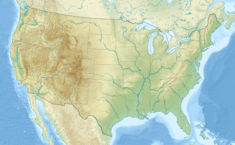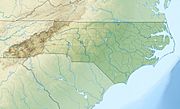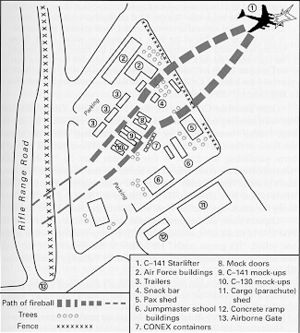Green Ramp disaster facts for kids

Wreckage of the Lockheed C-141 Starlifter destroyed by the accident.
|
|
| Accident summary | |
|---|---|
| Date | March 23, 1994 |
| Summary | Mid-air collision caused by ATC and pilot error |
| Place | Pope Air Force Base, North Carolina, U.S. 35°10′05″N 79°01′30″W / 35.168°N 79.025°W |
| Total injuries (non-fatal) | over 100 |
| Total fatalities | 24 (on ground) |
| First aircraft | |
| Type | General Dynamics F-16D Fighting Falcon |
| Airline/user | United States Air Force |
| Registration | 88-0171 |
| Crew | 2 |
| Survivors | 2 |
| Second aircraft | |
| Type | Lockheed C-130E Hercules |
| Airline/user | United States Air Force |
| Registration | 68-10942 |
| Crew | 3 |
| Survivors | 3 |
| Third aircraft | |
| Type | Lockheed C-141B Starlifter |
| Airline/user | United States Air Force |
| Registration | 66-0173 |
The Green Ramp disaster was a very serious accident that happened in 1994. It involved a mid-air collision (when two planes hit each other in the sky). This collision then led to another crash on the ground at Pope Air Force Base in North Carolina.
Tragically, twenty-four soldiers from the U.S. Army's 82nd Airborne Division died. They were getting ready for a training exercise where they would jump out of planes.
This event is still the largest loss of non-passenger lives from an accidental plane crash in the U.S. It was also the worst loss of life for the 82nd Airborne Division during peacetime since World War II.
Contents
The Green Ramp Accident
The "Green Ramp" is a large area at Pope Air Force Base. It's used by the U.S. Army and Air Force for joint training. Several buildings are located along its edge. One of these was Building 900, which housed Air Force operations.
Next to Building 900 was a "pax shed." This was a large building where soldiers prepared for parachute jumps. There was also a big grassy area where troops could gather before their jumps. Concrete models of cargo planes were built nearby for practice.
On the day of the accident, about 500 paratroopers from Fort Bragg were in these areas. They were getting ready to board several large cargo planes. These planes included C-130 Hercules and C-141 Starlifter aircraft. At the same time, other planes were flying training missions in the sky. These included F-16 Fighting Falcon and A-10 Thunderbolt II jets, along with C-130s.
What Happened in the Air?
On Wednesday, March 23, 1994, just after 2:00 PM, a two-seat F-16D Fighting Falcon jet was practicing a special landing. This practice is called a "simulated flameout" (SFO) approach. It means the pilot pretends the engine has stopped working.
During this practice, the F-16 jet (with two pilots, Captains Joseph Jacyno and Scott Salmon) hit a C-130E Hercules cargo plane. The C-130 had three crew members: Captain Jose Raices, Lieutenant Adam Zaret, and Sgt. Joel Myers. Both planes belonged to the same unit at Pope Air Force Base.
The planes were very close to the runway, about 300 feet (91 meters) above the ground. The front of the F-16 cut off the C-130's right tail part, called an elevator. After the hit, the F-16 pilot tried to save the plane by using full afterburner (a way to get extra power). But the F-16 started to break apart. Pieces of the plane fell onto the runway and a nearby road.
Both F-16 pilots used their ejection seats to escape the plane. The F-16, still with its engine on full power, flew in a curve towards the Green Ramp. Meanwhile, the C-130 crew flew their damaged plane away from the airfield. They checked to see if it was safe to land. The C-130 crew knew they had been hit, but not how badly. After their checks, they returned and landed safely on the runway, which was now covered in debris.
The Crash on the Ground
By the time the C-130 landed, the F-16 had crashed onto the Green Ramp. It hit an empty parking spot between two other C-130 planes. These planes had crews inside getting them ready to leave. When the F-16 hit the ground, its wreckage slid forward. It crashed into the right wing of a C-141B Starlifter cargo plane. This C-141 was also parked on the ramp.
The C-141 crew was preparing for a joint Army-Air Force operation. However, no Army troops had boarded it yet, except for the jumpmaster team. The F-16 wreckage broke open the fuel tanks in the C-141's right wing. This caused a huge fireball. This fireball, along with the F-16 wreckage, kept moving. It went between Building 900 and the pax shed. This was exactly where many Army paratroopers were sitting and standing.
Twenty-three soldiers died right away. More than eighty were injured. One soldier who was badly burned died later, about nine months after the accident.
Soldiers at the scene bravely pulled their friends from the flames. They also had to deal with ammunition from the F-16 exploding due to the heat. Medical teams from the Army and Air Force quickly arrived. They took the injured to nearby hospitals. Some were taken to Womack Army Medical Center at Fort Bragg. Others went to Cape Fear Valley Medical Center in Fayetteville. Some of the most severely burned were flown to the burn center at UNC Hospitals in Chapel Hill.
The Aftermath of the Accident
Two days after the accident, President Clinton visited the site. He also met with the injured soldiers at Womack Army Medical Center. Some of the most seriously burned victims were taken to a special research center in Texas. Two months after the accident, most of the injured were recovering well. Only one paratrooper was still in critical condition.
The U.S. Air Force investigated the accident. They found that most of the blame for the mid-air collision was on the military and civilian air traffic controllers. These are the people who guide planes from the ground. The investigation said that air traffic control made "multiple errors."
The F-16 pilot was also partly to blame. Air Force rules say pilots must "see and avoid" other aircraft. However, there were special circumstances. The pilot said he did not see the C-130. But after the control tower told him about it, he started his landing approach, and then the collision happened.
Two Air Force officers involved in the crash were moved to different jobs. Three enlisted airmen also faced disciplinary action. A later investigation said that mistakes by the F-16 pilots also played a part in the accident. However, no further disciplinary action was taken against the pilots.





